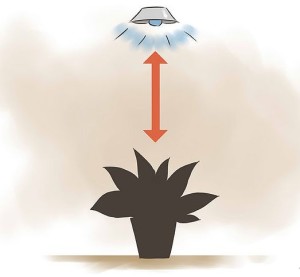Grow Lighting for Plants
During photosynthesis, plants use energy in the region of the electromagnetic spectrum from 400-700 nanometers. The radiation in this range, referred to as Photosynthetic Active Radiation (PAR). Grow lighting for plants requires this blue/red spectrum which provides the most efficient food for plants. Plants use the full spectrum for photosynthesis, although red and blue light seem to be most critical. Red light stimulates vegetative growth and flowering, but if a plant gets too much red light, it will become tall and spindly. Blue light regulates plant growth, which makes it ideal for growing foliage plants and short, stocky seedlings.
The Induction full spectrum lighting fixture presented is designed to be used in plant growing applications and replaces up to 1000 watt HID lighting with 50% energy savings.
Besides Induction, there are several types of grow lighting for plants available for indoor gardening and each type of grow light offers advantages and disadvantages. let’s review;
HID Plant Grow Lights – The light source of choice for most plant growers has been the high intensity discharge (HID) lamps. The two types of HID grow lights are metal halide (MH) and high-pressure sodium (HPS). Both emit a much more intense light. Typically indoor gardeners will use metal halide to grow their plants and HPS to fruit and flower their plants.
Metal halide (MH) bulbs produce an abundance of light in the blue spectrum. This color of light promotes plant growth and is excellent for green leafy growth and keeping plants compact. Metal halide grow lamps are ideal for plants that are in a vegetative stage. The vegetative state is the stage in a flowering plant’s life cycle before the appearance of its fruiting structure. In the vegetative state, plants rush to grow leaves and stems that will feed and support the fruits of the flowering or bloom stage.
Up until now, metal halide grow lights has been the best type of indoor light to be used as a primary light source. With the average lifespan at 10,000 hours, metal halide grow bulbs should be replaced about once a year.
High Pressure Sodium Grow Lights
High pressure sodium (HPS) bulbs emit an orange-red glow. This band of light triggers hormones in plants to increase flowering/budding in plants. They are the best lights available for secondary or supplemental lighting (used in conjunction with natural sunlight). This is ideal for greenhouse growing applications. Their disadvantage is they are deficient in the blue spectrum.
Fluorescent Grow Bulbs
This type of light is perfect for starts and seedlings. Fluorescent grow bulbs are low intensity and need to be placed within 8″ of the plants to be most effective. However, fluorescent bulbs are a poor light source for flowering and budding stages.
Incandescent Grow Bulbs
These lights are good for starts and seedlings as well and provide an inexpensive option to metal halide grow lights, because they do not require a ballast. These lights are primarily used for individual plants or small groups of indoor plants.
 Grow Lighting for Plants
Grow Lighting for Plants
The Right Intensity -The higher the wattage the further away you want the light to be from your plants due to the amount of heat. HID lighting will be further away than a fluorescent fixture because of this. When mounting your lighting fixture take into account the type of plant and how tall the plant will grow. You want to keep the light as close as you can, but not so close to burn the plant.
The intensity of light that a plant receives is determined by the wattage of the bulb and by how close the plant is to the light source. A simple rule is “if it is comfortable for the back of your hand, it will be a safe distance for your plants”.
LED Grow Lights
The most expensive aspect of indoor gardening is the power that it takes to operate indoor grow lights and cool the growing area. Since the traditional HID grow lights use much more energy and generate a lot more heat, they cost much more to run, many commercial and personal growers are turning to LED grow lights. LED lighting generates much less heat while providing dramatic energy savings over traditional grow lights.
Induction Grow Lights
Grow Light Lamps understands that proper grow lighting for plants is essential for healthy plant growth. Our new innovated and easy to install Induction Grow Lights do just that. Compared to other grow lights, Induction grow lighting for plants are attractive because they do not require ballasts and produce considerably less heat. This allows the Induction grow light to be placed closer to the plant canopy than other lights. Our Induction Grow Lights come with an impressive average life span of 100,000 hours and a manufacturer 10 Year warranty. These grow lights are ideal for all phases of plants growth and flowering. This system is suitable for grow tents, greenhouses and Hydroponic systems.






